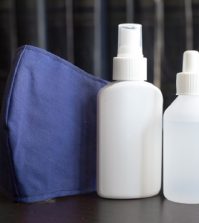- Study Says Most Parents Don’t Use Car Seats In Ride Share Vehicles Like Uber
- This 12-Year-Old Boy Is A Sophomore Aerospace Engineering Major!
- Fire Safety Experts Warn Of Hand Sanitizer Danger After A Mom and Kids Escape House Fire
- Recall Alert: Peaches May Be The Cause Of Salmonella Outbreak, 68 People Ill
- Summer Vacation In The Days Of COVID: Tips To Stay Safe
- How To Safely Grocery Shop During The Coronavirus Pandemic
- Michigan Teen With Vape-Related Illness Undergoes Double Lung Transplant
- Teen Kicks Off Anti-Vaping Campaign From Hospital Bed
- Teenager Receives Life Sentence For Strangling Sister To Death Over A Wi-Fi Password
- Toddler Falls To Death From 11th Deck of Cruise Ship
Children Exposed To Chemicals In 9/11 ‘Dust’ Show Signs Of Heart Disease


A new study says over 100 children who were exposed to chemical fumes from the 9/11 attacks have a far higher risk of heart disease than they should.
After the Twin Towers fell on September 11, 2001, the disaster site was omitting toxic fumes of mercury, asbestos, as well as jet fuel.
Experts say that the fumes lingered until at least July 2002, when the clean-up was declared complete.
Now, an analysis done by NYU Langone Health researchers of 308 children in the World Trade Center Health Registry (WTCHR) has shown the devastating impact this had on young people.
The 123 children with higher blood levels of the chemicals known to be in the dust had a 15 percent increase in levels of artery-hardening fats in their blood.
This is the first concrete study to lay bare the long-term cardiovascular health risks in children from toxic chemical exposure on 9/11.
At the time, nobody knew that the site would leave more than 500,000 people with a heightened risk of incurable cancers and heart conditions.
In fact, a week after the attacks the EPA had assured citizens that the site ‘did not pose a health hazard’.
The agency has since admitted that statement was wrong – and some say that even today people living in Lower Manhattan are exposed to dangerous fumes.
As of last year, Mount Sinai’s World Trade Center Health Program had counted more than 5,400 people with 9/11-related cancers. And now this study has also shown how the fumes impacted the hearts of children.
‘Since 9/11, we have focused a lot of attention on the psychological and mental fallout from witnessing the tragedy, but only now are the potential physical consequences of being within the disaster zone itself becoming clear,’ says study lead investigator and health epidemiologist Dr Leonardo Trasande.
Study children who were more likely to be exposed to the dust, who are mostly young adults now, were enrolled in the WTCHR.
The registry is helping to track the physical and mental health, through annual check-ups, of nearly 2,900 children who had either lived or attended school in Lower Manhattan on the day of the 9/11 attack.
Dr Trasande says that the long-term danger may stem from exposure to certain perfluoroalkyl substances, or PFASs – chemicals released into the air as electronics and furniture burned in the disaster.
The September 11 attacks also referred to as 9/11, were a series of four coordinated terrorist attacks by the Islamic terrorist group al-Qaeda on the United States on the morning of Tuesday, September 11, 2001. The attacks killed 2,997 people, injured over 6,000 others, and caused at least $10 billion in infrastructure and property damage.
The destruction of the World Trade Center and nearby infrastructure caused serious damage to the economy of Lower Manhattan and had a significant effect on global markets, resulting in the closing of Wall Street until September 17 and the civilian airspace in the U.S. and Canada until September 13.
Before September 11, 2001, a massive terrorist attack against the United States seemed unimaginable to most Americans. But 16 years later, the events of that day continue to affect the way in which Americans live.









0 comments